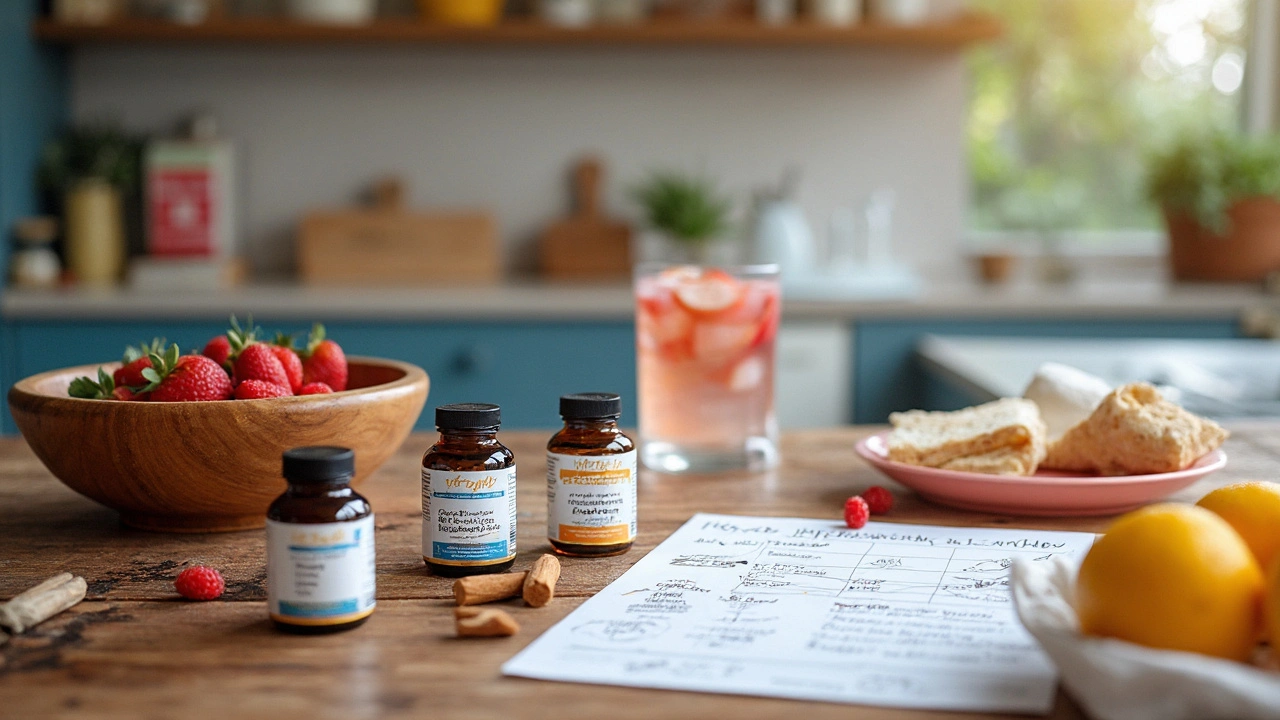How Natural Plant-Based Supplements Mimic Metformin
If you ever typed “metformin alternatives” into your browser, you’re probably not alone. Prescription meds like metformin are a standard go-to for blood sugar management, but there are plenty of reasons to wonder: what if you could get similar results from plants and foods you recognize—without a trip to the GP?
Metformin works by making your cells more sensitive to insulin, lowering how much sugar your liver dumps into your blood, and even slowing the absorption of carbs from your gut. Nature, surprisingly, has a few tricks up its sleeve that tap into these same targets (not bad for something out of the ground or spice rack, right?). Let’s look at some standout options backed by real evidence.
- Berberine: Found in plants like goldenseal and barberry, berberine’s blood sugar-lowering effect is so impressive it’s sometimes called “nature’s metformin.” Clinical studies show berberine can reduce fasting glucose, post-meal spikes, and even long-term HbA1c levels—pretty much like metformin does. One little-known fact: it's also used in traditional Chinese medicine for gut health.
- Cinnamon: And not just as a sprinkle on porridge. Ceylon cinnamon in higher concentrations has been shown to improve insulin sensitivity and curb blood sugar spikes after meals. A tablespoon (not the entire jar please) daily in the diet can have measurable effects.
- Bitter Melon: Used in Asia and Africa (it looks weird but tastes surprisingly good stir-fried), bitter melon contains compounds that act like insulin, helping sugar move into your cells more easily. Some small studies have shown a reduction in both fasting and post-meal glucose.
- Gymnema Sylvestre: Known as the “sugar destroyer” in India, this plant literally reduces your taste for sweets. But the magic isn’t just in your mouth—it can blunt sugar absorption in the gut too, making it harder for sugars to hit your bloodstream all at once.
- Alpha-Lipoic Acid: While your body makes this antioxidant, you can also get more from food (spinach, broccoli, potatoes) or supplements. Research ties it to lower fasting glucose and better insulin action, especially for those with nerve issues or early-stage insulin resistance.
If you want a deep-dive into these, natural metformin alternatives gives a top-to-bottom breakdown of what actually works—and what’s mostly hype.
What’s important to know? These plant-based options aren’t magic bullets, and some (like berberine) may tweak your gut in the beginning. Always check for interactions, especially if you’re on meds. The upside: most people report few side effects compared to prescription drugs, and these supplements rarely break the bank.
“The best thing about plant-based alternatives is they work synergistically with lifestyle changes. You’re not ‘off the hook’ because you’re taking a supplement, but they can bridge the gap when diet isn’t perfect.” — Dr. Chloe Gooding, Bristol-based nutrition scientist
Lately, research from the University of Southampton found that nearly 15% of UK adults with prediabetes were already trying one or more of these plant-based supplements along with diet tweaks. Curious what happens if you just stick with smart food choices? That’s coming up next.

Power Foods and Smart Meal Strategies for Lower Blood Sugar
Let’s get real: skipping dessert won’t magically solve your glucose issues. Stable blood sugar doesn’t come from deprivation, but from working with your body’s rhythms and feeding it foods that keep things balanced. Every person’s body is a test kitchen, but a few solid rules pop up again and again in actual studies (and yes, they work even if you can’t remember the last time you saw a veggie market).
- Skip Naked Carbs: carbs on their own—toast, juice, sugary cereal—cause blood sugar jumps. But if you pair them with fat or protein (think apple slices with peanut butter, or a slice of cheese on whole-grain crackers), you actually slow how fast sugar enters your bloodstream.
- Make Fibre Your Friend: Soluble fibre (from oats, beans, lentils, seeds, and a lot of root veg) makes a huge difference. Gram for gram, adding 10g of fibre daily lowers HbA1c by 0.25% on average. Try eating a rainbow: more veg per meal, seeds mixed into porridge, even an extra portion of beans is a win.
- Sour Power: Apple cider vinegar, yes, is back in fashion for a reason. Multiple randomized trials show that a tablespoon of ACV before starchy meals can cut post-meal blood sugar by 20–30%. Try mixing it with water or salad dressings—my kids think of it as “tangy potion” (Jeremy grimaces every time, but it works).
- Go for Lower Glycaemic Index (GI) Options: White bread and rice are fast-acting, while brown rice, quinoa, or sourdough act slower. One of the easiest swaps in real life? Swap your white toast for seeded wholegrain—Lois barely noticed the difference, but my energy lasted through the morning madness.
- Don’t Drink Your Sugar: Sweet drinks—even fruit juice—are a quick blast of glucose. If you want the nutrition, eat the actual fruit. Water down juices, try sparkling water with lemon, or go all-in on herbal teas.
- Timing Counts: Eating the largest meal at lunch instead of dinner helps your body metabolize sugar more efficiently. It’s not just what, but when. That mid-afternoon walk? Adds up big over a week.
| Food | Key Compound | Blood Sugar Benefit |
|---|---|---|
| Oats | Beta-glucan fiber | Slows sugar absorption, lowers spikes |
| Lentils | Soluble fiber, plant protein | Improves insulin response |
| Cinnamon | Cinnamaldehyde | Improves insulin sensitivity |
| Apple Cider Vinegar | Acetic acid | Lowers post-meal glucose |
You don’t need a nutritionist on speed dial. Most of these swaps are cheap and take minutes. A tip from my own chaos-prone kitchen: batch-cook a base (like lentils or roasted veggies) on Sunday. You can throw them into wraps, soups, or stir-fries all week. My kids don’t even notice half the vegetables I sneak in, and blood sugar numbers look better for it.
Having trouble figuring out if these changes are doing anything? Track your fasting sugars and how you feel after meals for a week. More even energy, less mid-afternoon crash, and better sleep are all decent clues your blood sugar’s on track—even if you’re not pricking your finger constantly.
Don’t forget, staying hydrated helps too; a dehydration study (2023, University of Manchester) showed that even mild dehydration could bump up glucose readings by 6–8%. So, yes, fill that water bottle before you grab your lunch.

Lifestyle Tweaks That Boost Natural Blood Sugar Control
What you eat sets the stage, but other habits can make plant-based supplements and healthy foods way more effective. It’s not about training for the Olympics or living like a monk—you can work smart tweaks into daily life and still keep things real (even if ‘real’ looks like me herding two fractious kids out the door).
- Move Your Body (a Bit Goes Far): Even a brisk 10-minute walk after meals gets muscles pulling sugar from your blood—kids in tow or solo, it all helps. One study from King’s College London showed that three short walks after meals trounced a 30-minute block of gym time for lowering post-meal glucose.
- Sleep Is a Secret Weapon: Shortchanging sleep just two nights in a row makes your cells less responsive to insulin. Going to bed even 30 minutes earlier can tilt the odds in your favour (I sneak in podcasts to help wind down post-kid bedtime chaos).
- Tame Your Stress: Easier said than done, but stress hormones tell your liver to release even more sugar. Tiny rituals like deep breathing or a two-minute stretch before dinner really do take the edge off—for you and everyone at your table.
- Set a Routine: Eating at regular times trains your body when to expect sugar, which helps stabilize the release of insulin and other hormones. Erratic eating confuses your body’s rhythm—regularity actually makes your natural blood sugar control way more efficient.
- Keep Your Gut Happy: Probiotic-rich foods like yoghurt, kimchi, and sauerkraut feed your good bacteria, which in turn help with metabolism. Those bacteria also churn out short-chain fatty acids, which tell your liver to calm down on spit-balling out extra sugar.
The best part? You don’t need to overhaul your life for things to shift. I’ve had phases where I barely managed four or five good meals a week, plus a couple of short walks, but the numbers still trended better. Progress, not perfection, right?
If you’re already using any herbs or supplements, keep an eye on your numbers, especially if you’re also using medications. And if you ever feel off—dizzy, super thirsty, or weirdly tired—get a proper checkup. Combining plants, food, and lifestyle is powerful, but ‘natural’ doesn’t always mean safe for every situation.
Quick cheat sheet for those chasing practical wins:
- Pair carbs with protein or fat to slow sugar spikes
- Add fibre (beans, seeds, veggies) to each meal
- Try a plant-based supplement (like berberine or Gymnema) for an extra boost
- Work in short walks and aim for steady meal times
- Track what helps you feel your best—real results show up as more than numbers
Managing blood sugar naturally is a mix of clever food choices, strategic supplements, and gentle shifts in your day-to-day. There’s no one-size-fits-all, but most people find their sweet spot with a handful of these building blocks and a dose of real-life flexibility. The energy, steadier moods, and fewer crashes don’t hurt either—and, trust me, you don’t need to live like a saint for them to kick in. Stay curious, experiment, and celebrate those little wins at your own family table.

Crystle Imrie
April 30, 2025 AT 01:24Sure, swapping metformin for cinnamon sounds like a witch‑doctor’s quick fix, not science.
Shelby Rock
May 3, 2025 AT 01:24i've been thinkin bout how nature’s pharmacy is like a ancient library, full of hidden chapters we barely skim. the article mentions berberine and bitter melon, but it forgets the humble fenugreek that’s been used for centuries. maybe the real magic is in the balance, not just in throwin a single spice on your toast. remember, the best recipe is the one that fits your own story.
Dhananjay Sampath
May 6, 2025 AT 01:24Great overview, and I’d add that pairing these supplements with consistent meal timing can really amplify their effect, because your body responds best when it knows when to expect nutrients, which in turn helps insulin sensitivity, and don’t forget to stay hydrated, especially when increasing fiber intake.
kunal ember
May 9, 2025 AT 01:24The article provides a solid foundation for anyone looking to replace or complement metformin with plant‑based alternatives, and it does so by systematically breaking down the mechanisms of each herb. Berberine, for instance, has been shown in multiple randomized controlled trials to activate the AMP‑activated protein kinase pathway, a key regulator of glucose metabolism that metformin also targets. Cinnamon’s active component, cinnamaldehyde, improves insulin receptor function, which can lead to modest reductions in fasting glucose when consumed regularly. Bitter melon contains charantin and polypeptide‑p, both of which mimic insulin signaling at the cellular level, though the evidence is still emerging and dosage standardisation remains a challenge. Gymnema sylvestre’s ability to suppress sweet‑taste receptors is fascinating, but the most clinically relevant effect appears to be its capacity to inhibit intestinal glucose absorption, thereby flattening post‑prandial peaks. Alpha‑lipoic acid, while primarily recognised for its antioxidant properties, also enhances peripheral glucose uptake, which is particularly beneficial for patients with early neuropathic complications. When you combine any of these agents with a high‑fiber diet, you create a synergistic environment where glucose entry into the bloodstream is both slowed and more efficiently utilised. The practical tip about pairing carbohydrates with protein or fat is not merely anecdotal; it is supported by kinetic studies showing a 30‑40 % reduction in glycaemic index when macronutrients are co‑ingested. Moreover, the inclusion of soluble fiber sources such as oats or legumes adds a viscous gel that further delays gastric emptying, a mechanism that works hand‑in‑hand with berberine’s AMPK activation. It is also worth noting that apple cider vinegar’s acetic acid component can impede the activity of disaccharidases in the brush border, which translates into a blunted rise in post‑meal glucose levels. From a lifestyle perspective, the recommendation to shift the largest meal to midday aligns with circadian rhythms that dictate insulin sensitivity, a fact corroborated by chronobiology research from several European institutions. Short, post‑meal walks have been demonstrated to stimulate GLUT4 translocation in skeletal muscle, thereby providing an immediate glucose‑clearing effect that supplements alone cannot achieve. While the article correctly cautions about potential interactions-especially the CYP450 inhibition seen with berberine-most of these herbs have a favourable safety profile when taken at recommended doses. However, patients on anticoagulants should monitor for increased bleeding risk with high doses of cinnamon, and those with thyroid disorders need to be aware of Gymnema’s mild antithyroid activity. In practice, I would start with a low dose of berberine, assess tolerance, and gradually introduce cinnamon or alpha‑lipoic acid, all while maintaining a food diary to track glucose trends. Ultimately, the goal is not to replace metformin outright for everyone, but to provide a toolbox of evidence‑based options that can reduce reliance on pharmaceuticals, improve quality of life, and empower individuals to take charge of their metabolic health.
Kelly Aparecida Bhering da Silva
May 12, 2025 AT 01:24Don't be fooled by the mainstream narrative that says only big‑pharma can control blood sugar – they've been quietly suppressing natural alternatives for decades, and now they're finally scared that berberine might cut their profits. The evidence is out there, hidden in pay‑walled journals, but the hype machine keeps us chasing pills.
Michelle Dela Merced
May 15, 2025 AT 01:24💥💊 Yeah, it's like the government wants us hooked on synthetic meds while we have ancient herbs right in our backyard! 🇺🇸💚 Let's bring the power back to the people, one cinnamon stick at a time! 🌿✨
Alex Iosa
May 18, 2025 AT 01:24It is imperative to consider that certain research funding agencies have vested interests, which may bias the reporting of outcomes for plant‑based interventions. Consequently, clinicians should critically evaluate the methodology before endorsing widespread supplementation.
melissa hird
May 21, 2025 AT 01:24Ah, yes, because the only way to trust scientific literature is to assume every study is a covert operation – a truly groundbreaking revelation. 🙄
Mark Conner
May 24, 2025 AT 01:24Look, if we all started farming our own bitter melon and cinnamon, we’d be less dependent on foreign drug companies trying to control our health.
Charu Gupta
May 27, 2025 AT 01:24While your enthusiasm for self‑sufficiency is commendable, it remains essential to adhere to dosage guidelines and monitor potential interactions – a responsible approach ensures safety. 📚✅
Abraham Gayah
May 30, 2025 AT 01:24Honestly, reading this feels like watching a kindergarten science class try to explain insulin – cute, but far from the sophisticated metabolic orchestration we truly need.
rajendra kanoujiya
June 2, 2025 AT 01:24Maybe the real sophistication lies in simplicity; sometimes the most complex explanations miss the point that basic diet tweaks can do wonders.
Caley Ross
June 5, 2025 AT 01:24I’ve tried adding a small amount of berberine to my morning routine and, combined with a brisk walk after lunch, I’ve noticed steadier energy without any dramatic spikes.
Bobby Hartono
June 8, 2025 AT 01:24i totally get where you're coming from, and i think it's important to remember that everyone's metabolism is like a unique puzzle piece, so what works for one might need tweaking for another. the combination of berberine with consistent post‑meal walks creates a two‑pronged approach: one that targets cellular glucose uptake and another that boosts peripheral muscle usage of that glucose. additionally, staying hydrated amplifies the fibre's gel‑forming effect in the gut, which further smoothes out blood sugar curves. i've also found that adding a splash of apple cider vinegar before carbs can shave off another few points from the post‑prandial spike, especially when the meal includes starchy veggies. don't forget to monitor your fasting numbers weekly, because small trends add up over time and help you fine‑tune dosages without over‑relying on any single supplement. moreover, the gut microbiome thrives on the soluble fiber from oats and lentils, and a happy gut can indirectly support insulin sensitivity. finally, keep a simple log of what you eat, which supplements you take, and how you feel – this real‑world feedback is often more telling than lab results alone. stay patient, stay curious, and celebrate each little improvement you notice along the way.
George Frengos
June 11, 2025 AT 01:24By integrating evidence‑based herbal supplements with balanced nutrition and regular activity, we empower ourselves to achieve sustainable glycemic control and a higher quality of life.